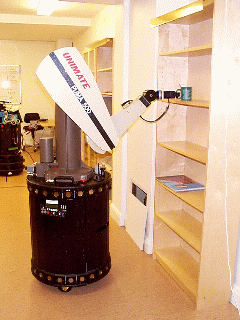Mobile Manipulation
Inverse kinematics and Trajectory Control
|
 Our mobile manipulator is composed of a Nomad XR4000 platform on the
top of which a Puma 560 arm is mounted.
At kinematic level a mobile manipulator can be interpreted as a
redundant open kinematic chain i.e. a classical arm
manipulator with more joints than degrees of freedom.
A kinematic chain can be inteded as a cascade of rigid body motions
each of them describing the displacement of
joint with respect to the adjacent ones.
Here we use the framework of exponential coordinates to
describe rigid body transformation.
Such a formalism relies on the Lie group structure that can naturally
be associated with the set of rotations and
translations in 3D space.
For an open kinematic chain, the problem of planning a motion is
basically composed of two parts:
the first is to find a suitable trajectory for the end effector, the
second is to translate this trajectory into a
corresponding trajectory for the joints of the manipulator, to be used
as reference input to the system.
This last problem is known as inverse kinematics and it is what is of
main concern here because of the redundacy
introduced by the presence of more joints than degrees of freedom.
The inverse kinematics is solved by integrating an equation
describing the differential kinematics of the manipulator.
Indeed, this is the situation in which the formalism of exponential
coordinates fits naturally since it is based on
representing any motion as (explicit) integral of some linear
differential equation.
Our mobile manipulator is composed of a Nomad XR4000 platform on the
top of which a Puma 560 arm is mounted.
At kinematic level a mobile manipulator can be interpreted as a
redundant open kinematic chain i.e. a classical arm
manipulator with more joints than degrees of freedom.
A kinematic chain can be inteded as a cascade of rigid body motions
each of them describing the displacement of
joint with respect to the adjacent ones.
Here we use the framework of exponential coordinates to
describe rigid body transformation.
Such a formalism relies on the Lie group structure that can naturally
be associated with the set of rotations and
translations in 3D space.
For an open kinematic chain, the problem of planning a motion is
basically composed of two parts:
the first is to find a suitable trajectory for the end effector, the
second is to translate this trajectory into a
corresponding trajectory for the joints of the manipulator, to be used
as reference input to the system.
This last problem is known as inverse kinematics and it is what is of
main concern here because of the redundacy
introduced by the presence of more joints than degrees of freedom.
The inverse kinematics is solved by integrating an equation
describing the differential kinematics of the manipulator.
Indeed, this is the situation in which the formalism of exponential
coordinates fits naturally since it is based on
representing any motion as (explicit) integral of some linear
differential equation.
A Mathematica package containing routines for trajectory
generation and kinematic inversion for the mobile manipulator can be
found here: Mobman.m
Last updated: June, 21st 1999.
 Our mobile manipulator is composed of a Nomad XR4000 platform on the
top of which a Puma 560 arm is mounted.
At kinematic level a mobile manipulator can be interpreted as a
redundant open kinematic chain i.e. a classical arm
manipulator with more joints than degrees of freedom.
A kinematic chain can be inteded as a cascade of rigid body motions
each of them describing the displacement of
joint with respect to the adjacent ones.
Here we use the framework of
Our mobile manipulator is composed of a Nomad XR4000 platform on the
top of which a Puma 560 arm is mounted.
At kinematic level a mobile manipulator can be interpreted as a
redundant open kinematic chain i.e. a classical arm
manipulator with more joints than degrees of freedom.
A kinematic chain can be inteded as a cascade of rigid body motions
each of them describing the displacement of
joint with respect to the adjacent ones.
Here we use the framework of